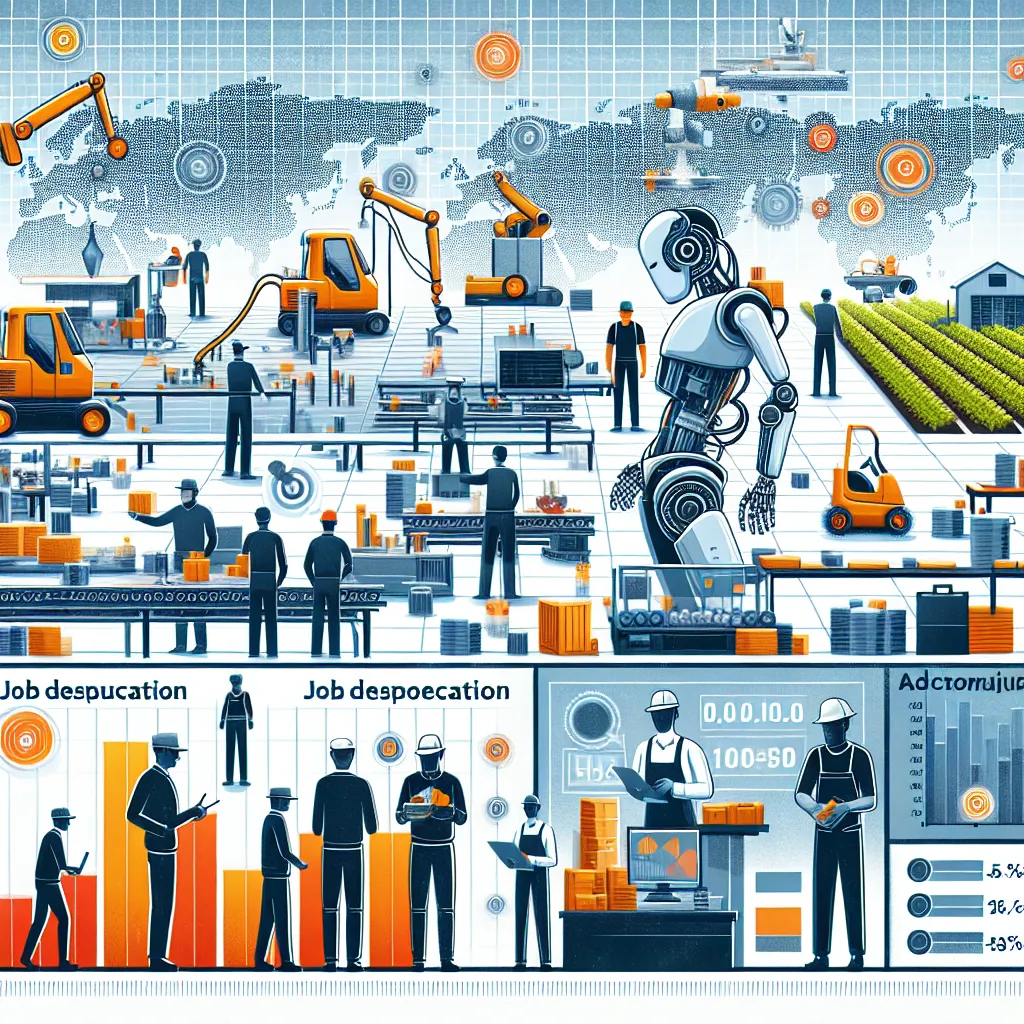The IELTS Reading section tests your ability to understand complex texts and answer questions accurately. One recurring theme in recent years has been the impact of technology on employment, particularly the “Effects of automation on low-skilled labor”. This topic has appeared in several past IELTS exams and remains highly relevant in today’s rapidly evolving job market. Given its significance, there’s a strong possibility it may feature in future tests. Let’s explore this subject through a practice reading passage and questions.
Nội dung bài viết
Reading Passage
The Changing Landscape of Low-Skilled Work in the Age of Automation
The dawn of the 21st century has ushered in an era of unprecedented technological advancement, with automation at the forefront of this revolution. While these innovations have brought about remarkable improvements in productivity and efficiency across various industries, they have also raised concerns about the future of low-skilled labor. The effects of automation on this segment of the workforce have been profound and multifaceted, reshaping the employment landscape in ways that were barely imaginable just a few decades ago.
One of the most immediate and visible impacts of automation has been the displacement of low-skilled workers in manufacturing and production lines. Robots and automated systems, capable of performing repetitive tasks with greater precision and speed than their human counterparts, have become increasingly prevalent in factories worldwide. This shift has led to significant job losses in traditional blue-collar sectors, particularly in developed economies where labor costs are higher. For instance, in the United States, it is estimated that automation has contributed to the loss of over 5 million manufacturing jobs since 2000.
However, the effects of automation are not limited to the manufacturing sector. Service industries, long considered a haven for low-skilled workers, are also experiencing rapid transformation. Self-service kiosks in fast-food restaurants, automated checkout systems in supermarkets, and AI-powered customer service chatbots are just a few examples of how automation is penetrating the service sector. These technological solutions are often more cost-effective for businesses in the long run, leading to a reduction in entry-level job opportunities that have traditionally been a stepping stone for many low-skilled workers.
The agricultural sector, too, has not been immune to the wave of automation. Advanced machinery and AI-driven systems are now capable of planting, monitoring, and harvesting crops with minimal human intervention. While this has led to increased productivity and reduced food costs, it has also resulted in a significant decrease in agricultural employment opportunities, particularly in rural areas where such jobs have been a mainstay of the local economy.
Despite these challenges, it would be overly simplistic to paint automation as entirely detrimental to low-skilled workers. The technological revolution has also created new job categories and opportunities. For instance, the rise of e-commerce has led to increased demand for warehouse workers and delivery drivers. While these roles may not require advanced degrees, they often demand a different skill set from traditional low-skilled jobs, emphasizing adaptability and basic technological literacy.
Moreover, automation has the potential to enhance workplace safety by taking over dangerous or physically demanding tasks, thereby improving working conditions for low-skilled laborers. It can also lead to the upskilling of the workforce, as employees are required to learn how to operate and maintain new technologies. This shift could potentially lead to better-paying jobs and career advancement opportunities for those willing to adapt and acquire new skills.
However, the transition is not without its challenges. The pace of technological change often outstrips the rate at which workers can retrain, leading to periods of unemployment and economic hardship. This mismatch between the skills demanded by the evolving job market and those possessed by low-skilled workers has contributed to growing income inequality and social unrest in many countries.
Governments and educational institutions are grappling with how to address these challenges. Some proposed solutions include implementing universal basic income programs to provide a safety net for displaced workers, investing in vocational training and lifelong learning initiatives to help workers adapt to new technologies, and exploring ways to ensure that the benefits of automation are more equitably distributed across society.
In conclusion, the effects of automation on low-skilled labor are complex and far-reaching. While it has undoubtedly led to job losses and economic disruption in certain sectors, it has also created new opportunities and the potential for improved working conditions. The key challenge for policymakers, businesses, and workers alike is to navigate this transition in a way that maximizes the benefits of technological progress while minimizing its negative impacts on vulnerable segments of the workforce. As we move further into the age of automation, finding this balance will be crucial for ensuring economic prosperity and social stability in the years to come.
 Impact of Automation on Low-Skilled Labor
Impact of Automation on Low-Skilled Labor
Questions
True/False/Not Given
For questions 1-5, read the following statements and decide if they are True, False, or Not Given based on the information in the passage.
- Automation has led to job losses primarily in the manufacturing sector.
- The service industry has been completely unaffected by automation.
- Automation in agriculture has resulted in lower food costs.
- E-commerce has created new job opportunities for low-skilled workers.
- All countries have implemented universal basic income programs to support displaced workers.
Multiple Choice
Choose the correct letter, A, B, C, or D for questions 6-8.
-
According to the passage, which of the following is NOT mentioned as an effect of automation on low-skilled labor?
A) Job displacement
B) Creation of new job categories
C) Increased workplace accidents
D) Need for upskilling -
The passage suggests that the transition to automated systems is challenging because:
A) New technologies are too complex for low-skilled workers to learn
B) The pace of change is faster than workers can adapt
C) Businesses are unwilling to invest in worker training
D) Governments are opposed to technological advancements -
Which of the following best describes the overall tone of the passage regarding the effects of automation on low-skilled labor?
A) Highly critical
B) Cautiously optimistic
C) Neutral and balanced
D) Enthusiastically supportive
Matching Headings
Match the following headings (A-F) to the paragraphs in the passage (questions 9-11). You may use any heading more than once.
A) The spread of automation beyond factories
B) Potential benefits of automation for workers
C) Government responses to automation challenges
D) The impact on manufacturing jobs
E) New opportunities in the digital economy
F) Challenges in adapting to technological change
- Paragraph 2
- Paragraph 6
- Paragraph 7
Summary Completion
Complete the summary below using words from the box. Write your answers in boxes 12-15 on your answer sheet.
The effects of automation on low-skilled labor are (12)__ and wide-ranging. While it has caused job losses in traditional sectors like manufacturing and agriculture, it has also (13)__ new types of jobs, particularly in e-commerce. Automation can potentially improve workplace (14)__ and lead to better-paying jobs for those who can adapt. However, the rapid pace of change has contributed to growing income (15)__ and social issues.
| complex | created | safety | inequality |
| simple | eliminated | efficiency | equality |
| limited | reduced | risk | disparity |
| extensive | increased | productivity | gap |
Answer Key and Explanations
-
False
Explanation: The passage states that automation has affected multiple sectors, not just manufacturing. It mentions impacts on service industries and agriculture as well. -
False
Explanation: The passage explicitly mentions that service industries are “experiencing rapid transformation” due to automation, giving examples like self-service kiosks and automated checkout systems. -
True
Explanation: The passage states, “While this has led to increased productivity and reduced food costs…” -
True
Explanation: The passage mentions that “the rise of e-commerce has led to increased demand for warehouse workers and delivery drivers.” -
Not Given
Explanation: The passage mentions universal basic income as a proposed solution but does not state that all countries have implemented such programs. -
C
Explanation: The passage does not mention increased workplace accidents as an effect of automation. In fact, it suggests that automation could enhance workplace safety. -
B
Explanation: The passage states, “The pace of technological change often outstrips the rate at which workers can retrain.” -
C
Explanation: The passage presents both positive and negative effects of automation on low-skilled labor, maintaining a balanced perspective throughout. -
D
Explanation: Paragraph 2 focuses on the impact of automation on manufacturing jobs. -
B
Explanation: Paragraph 6 discusses potential benefits of automation for workers, including improved safety and opportunities for upskilling. -
F
Explanation: Paragraph 7 describes the challenges workers face in adapting to rapid technological change. -
complex
-
created
-
safety
-
inequality
Common Mistakes to Avoid
- Overgeneralizing: Be careful not to assume that effects mentioned for one sector apply to all sectors.
- Misinterpreting “Not Given”: Remember that “Not Given” means the information is neither confirmed nor denied in the passage.
- Overlooking nuances: Pay attention to qualifying words like “some,” “often,” or “potentially.”
- Bringing in outside knowledge: Base your answers solely on the information provided in the passage.
Vocabulary
- Unprecedented (adjective) /ʌnˈpres.ɪ.den.tɪd/: Never having happened or existed in the past
- Multifaceted (adjective) /ˌmʌl.tiˈfæs.ɪ.tɪd/: Having many different aspects or features
- Prevalent (adjective) /ˈprev.əl.ənt/: Widespread in a particular area or at a particular time
- Penetrating (verb) /ˈpen.ə.treɪ.tɪŋ/: Succeeding in forcing a way into or through something
- Detrimental (adjective) /ˌdet.rɪˈmen.təl/: Causing harm or damage
- Upskilling (noun) /ˈʌpˌskɪl.ɪŋ/: The process of learning new skills or teaching workers new skills
- Grappling (verb) /ˈɡræp.əl.ɪŋ/: Struggling or wrestling with a problem or issue
Grammar Focus
Pay attention to the use of present perfect tense to describe recent changes and ongoing effects:
- “Automation has contributed to the loss of over 5 million manufacturing jobs since 2000.”
- “The technological revolution has also created new job categories and opportunities.”
This tense is often used in IELTS Reading passages to connect past events to the present situation.
Tips for IELTS Reading Success
- Practice time management: Allocate your time wisely between reading the passage and answering questions.
- Skim and scan effectively: Quickly identify key information without reading every word.
- Pay attention to paragraph structure: Topic sentences and concluding sentences often contain main ideas.
- Develop your vocabulary: Regularly learn new words in context to improve comprehension.
- Practice various question types: Familiarize yourself with all IELTS Reading question formats.
- Read actively: Engage with the text by underlining key points and making mental summaries.
- Stay calm under pressure: Remember that some questions are designed to be challenging.
By following these tips and regularly practicing with passages like this one on the effects of automation on economic inequality, you can improve your IELTS Reading skills and boost your confidence for the exam. Remember, success in IELTS Reading comes from a combination of language proficiency, strategic approach, and consistent practice.


